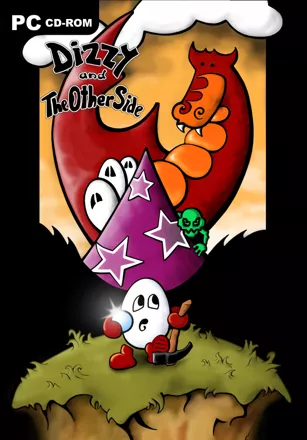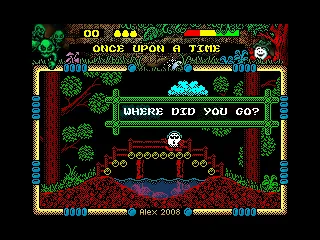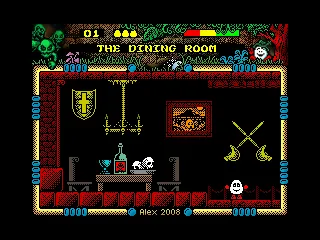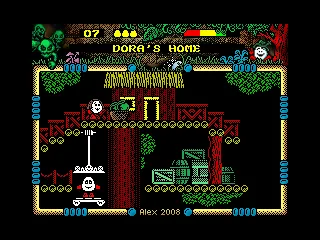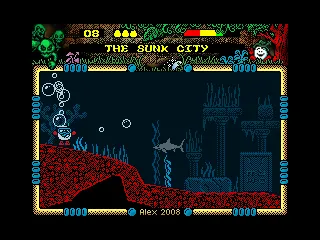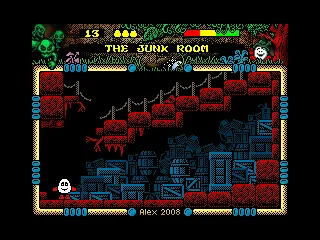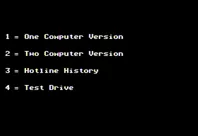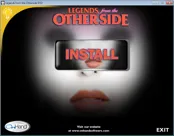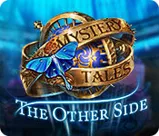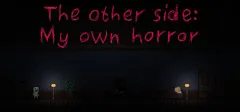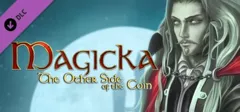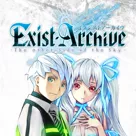Dizzy and the Other Side
Description
Dizzy and the Other Side is an adventure-platform game by Alexandru Simion, the creator of the Dizzy AGE engine which allows fans to make their own Dizzy games. The game was made with version 2.2 of the engine. Alongside the small games "Dizzy and the Healing Potion" and "Dizzy and the Mushroom Pie" it was one of the games that Alexandru and Cristina Simion made to test and show the capabilities of the recently announced engine.
In the game Dizzy is having a nice day when suddenly the wizard Zaks sends him to the other side to look for the missing Stone of Balance, a mysterious item that gives balance to all magic in the land. As usual, Dizzy has to travel through different areas and encounter many dangers before he can find the stone and return it to its place.
Unlike most Dizzy games, the game is divided into five levels or "acts". The full version was ready in 2008, but the initial "promo" version, containing just the first act and a short preview with screenshots from further areas with a "conversation between the player and the developer" (along the lines of "Please, just one more"), was released in 2006.
The game can be downloaded from the Dizzy AGE website, its own site or the Dizzy portal Yolkfolk.com. The game's site also hosts an ongoing competition where players can score a higher place through finding as many diamonds as possible (there are 60 of them, but some are hidden or hard to reach), shorter play time and fewer reloads.
Groups +
Screenshots
Credits (Windows version)
20 People (18 developers, 2 thanks)
| Game Created by | |
| Original Dizzy Games by |
|
| Beta-Testing | |
| Dialogs Revision | |
| Special Thanks to |
|
| Note |
|
Reviews
Players
Average score: 3.3 out of 5 (based on 3 ratings with 1 reviews)
You want more Dizzy? Here come the fan games!
The Good
The graphics look lovely. While there are of course many games with much better graphics, in a perspective - of Dizzy Spectrum graphics on which these sprites are based - they look amazing. Dizzy for Spectrum and other 8-bit computers had a very limited color palette, problems such as merging of white surfaces with background colors... Most Dizzy AGE games, as said, use the Spectrum sprites, but develop them much more, adding effects which weren't possible on these quite primitive computers. Some Dizzy AGE games look yet better, but also in "Dizzy and the Other Side" some places - for example the secret treasure room or the haunted church - feature beautiful light effects.
I like some interesting little effects found in this game - for example something I don't recall from any other Dizzy AGE game: Dizzy's face changes, depending on whether he feels normal or is worried, scared, angry... It's really a pity this minor but nice effect hasn't been taken to other games.
The melodies are quite pretty and they also change depending on places and moods.
The story is quite interesting. While original Dizzy games were charming, they never had complicated plots - lack of ideas, it seems... Here Dizzy has to go to the Other Side to look for a missing magical item and has a long way home before himself... In some other Dizzy AGE games there are yet more creative ideas - Dizzy is teleported to a spaceship with some eccentric machines ("Don't Panic Dizzy" by Simon Rice), meets the illusory opposites of his family ("Illusion Island Dizzy" by Jamie Douglas) or even is sent to a tropical island as a result of a political conspiracy ("Grogg Island Dizzy" by Matt Huckvale).
At one point (later part of Act I) the game splits into three paths (which meet again later, in Act II - the initial part of the act depends on the chosen route): you can choose one of three ways to travel across the sea. Just ask all the other characters from this act and you'll get the three answers you need.
Another nice aspect is the ending sequence - in most Dizzy games (either official or fan-made ones) it is far shorter. It includes a series of funny cutscenes, both of the type of "what happened next" and "the making of the game" - made as if the game was a movie, with... all right, I won't say, just play the game yourself if you want to see them. ;)
The game runs smoothly and has a very convenient feature: it can be saved. There are only three save slots, but it's still way better than playing the original games with no possibility to save. (Most Dizzy AGE games have a save option, only in some of them this option was maliciously removed or restricted to make the games more difficult...) However, the less times you reload, the higher you can get on the high score list on the game's website - the results depends on time spent playing, number of reloads and - most importantly - number of diamonds found. Actually the game's website is really helpful - if you get stuck (which isn't surprising - the game is quite difficult), you can find hints on the website. They are written in a nice way - not a full walkthrough, but rather series of hints you can reveal without spoiling other parts of the game if you don't want to.
The Bad
The story is actually quite complicated - it's not easy to get it when playing... Actually, along with the two sides of reality, there are two Dizzies in the game and the wizard Zaks is also duplicated - one is evil and the other one is good... Both of them send Dizzy to the Other Side, probably without knowing what he can expect there - so he isn't told anything and at first neither Dizzy nor Zaks realise the potion did work. What I'm complaining about is simply that it can be hard to understand the whole scheme of who moves where and how.
And a thing I definitely hate: gender stereotypes. OK, there is not that much of it - in this game Daisy is just a background character, most of the game is spent away from her - but when she appears (especially Act III and V), she simply seems a stereotypical dumb bimbo. Two examples:
1. A piece of dialog between Dizzy and Daisy which goes like this:
Dizzy: These levers have some sort of timer. It seems they can't be activated by a single person.(...)
Daisy: What do I have to do?
Dizzy: Just push it down when I say so.
- conclusion: Daisy is so stupid she can't understand the mechanism herself or even notice that Dizzy is pushing the lever if he doesn't tell her.
2. The cutscene near the end of Act V, when Dizzy (B) and Daisy (A) are going to the Temple of Balance to meet Dizzy (A) as arranged. "Hurry - Dizzy (B) says - Dizzy said we should meet him at the Temple of Balance". But Daisy had heard Dizzy (A)'s plan herself! Really, why does Dizzy treat her as an airhead in this game?! My quite serious suggestion: men who don't respect women should never enter any relationships with them, they simply have no such moral right. Unfortunately, Dizzy is a bit of this kind of guy in this game...
The Bottom Line
This game - at least its first "promo" version - was one of the first Dizzy AGE games. After Alexandru and Cristina Simion made the program itself, they created a few games to show its possibilities to others. The other ones were very short games, the pair's "Dizzy and the Mushroom Pie" and Cristina's "Dizzy and the Healing Potion", but "Dizzy and the Other Side" is a different story - a game comparable in length to the largest official Dizzy games and actually much more sophisticated in terms of storyline... Dizzy AGE was a real breakthrough for Dizzy: while several fan games were made in the period between the final official games and Dizzy AGE release, there were never so many of them and basically they were only made by computer near-professionals. Now almost anyone who understands a bit about computers can learn how to use Dizzy AGE and make his or her own games - and about a hundred Dizzy AGE games have been made so far.
Games such as the interesting Russian game "Dizzy Underground" (one of the earliest fan games) weren't accessible to anyone - you needed either a Spectrum computer or a Spectrum emulator, which probably wasn't even available in the early 90s. Dizzy AGE is much less demanding - these are all Windows games, as easy to run as in-built Windows games - and they are all free! So now is a time when Dizzy fans can really get all the games they want, probably much more than the Oliver Twins who created Dizzy ever imagined. Dizzy is a really puzzling phenomenon - while he was almost unknown in places such as the US and was mostly popular in just a few countries such as the UK and Eastern Europe (Russia, Romania, Poland...), this relatively limited fan base has been enough to keep him alive for so many years.
Windows · by Nowhere Girl (8680) · 2014
Analytics
Upgrade to MobyPro to view research rankings!
Related Sites +
-
Dizzy and the Other Side
Official website
Identifiers +
Contribute
Are you familiar with this game? Help document and preserve this entry in video game history! If your contribution is approved, you will earn points and be credited as a contributor.
Contributors to this Entry
Game added by Nowhere Girl.
Additional contributors: Karsa Orlong.
Game added January 1, 2014. Last modified February 13, 2023.
